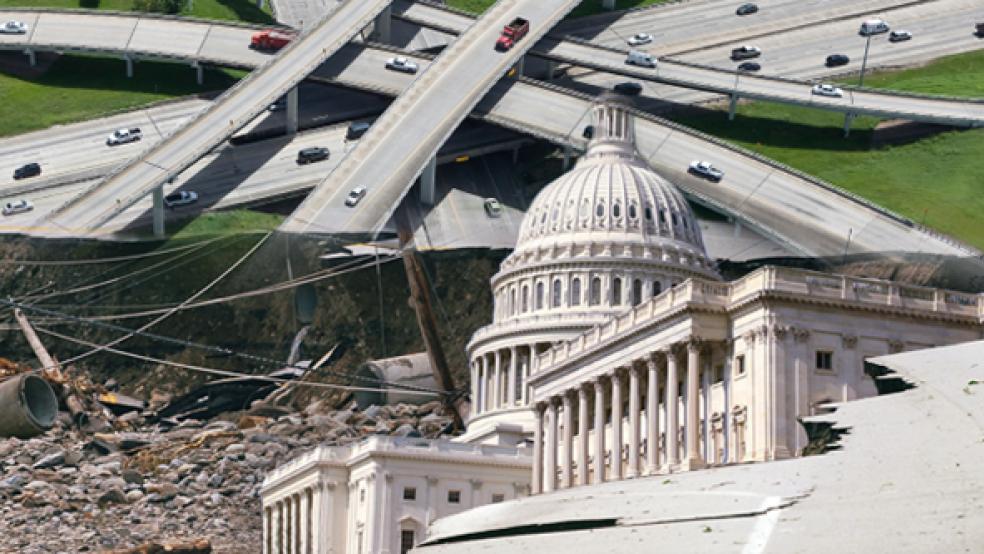Standard & Poor’s, which downgraded the U.S. credit rating last August after the government came close to defaulting on its debt, is now warning that another credit crisis could occur unless the government adequately funds long-term transportation and infrastructure spending.
In a new report, the major credit rating agency, which called highway, bridge and other transportation projects “the backbone of the U.S. economy,” raised concern that Congress has yet to pass a permanent extension of the U.S. highway spending bill. The latest continuing resolution, the 9th temporary extension, was approved by Congress on March 29 before lawmakers adjourned.
RELATED: Infrastructure Spending Gap Will Cost More Jobs
While the three-month extension will provide short-term spending for states and localities as they prepare for the summer construction season, many state officials remain concerned about the fate of long- term projects and planning. The federal government supplies states with about 45 percent of their funding for roads and bridges, according to the American Association of State Highway and Transportation Officials.
“The combination of reduced or unpredictable federal support and lower demand could result in deferred maintenance projects that would keep our nation’s transportation infrastructure in good repair,” the S&P report stated. “Such deferrals could hurt an entity’s credit if capital costs escalate over time, putting the system at risk.”
State governments finance major highway and bridge projects with revenue-backed bonds, or so-called GARVEE debt-financing instruments backed by a pledge of future federal aid for debt service. But if the federal revenue stream is uncertain or disrupted, state governments may have trouble marketing those bonds or need to pay a higher interest rate. “The political gridlock in Washington, D.C., and the doubt surrounding federal funding are making it difficult for issuers throughout the infrastructure sector to define long-term plans for funding necessary capital projects,” the S&P report states.
Last week Congress passed a stopgap three-month bill to keep federal highway and transit aid flowing and avoid a widespread shutdown of construction projects. The move pushes congressional action on a long-term overhaul of transportation programs deeper into a highly contentious election year.
Without action, Democrats estimated that as many as 1.8 million construction-related jobs were at risk just before the spring and summer construction season. The government would also have lost about $110 million a day in uncollected gas and diesel taxes. The last long-term transportation law expired in 2009, but programs have continued under a series of short-term extensions. The vote capped a see-saw struggle by House GOP leaders to pass their own five-year transportation plan.
Projects on the Backburner
A survey by The Fiscal Times of state transportation officials found that in the wake of the latest congressional action, states are putting many of their major long-term projects on the backburner while focusing on basic repairs of dilapidated roads and bridges.
Serge Phillips, federal relations manager for the Minnesota Department of Transportation, complained that his state has been in a holding pattern on federal aid for two years, and is worried about how much longer this uncertainty will continue. “We’re trying to problem-solve, to look at things statewide, continuing to protect public safety with repairs and provide for mobility and work on congestion,” Phillips said. “That doesn’t go away. Those are things we can’t compromise on. We’re trying to get by.”
Brent Walker, a spokesman for the West Virginia Department of Transportation, said that the inability of Congress to agree on permanent new legislation “certainly puts us in limbo.”“We try to plan out every six years,” Walker said. “If this goes on, we’d have to continue to practice triage, only in a bigger way because we’d be uncertain about the future.”
But putting many long-term projects on the shelf, while necessary for now, could seriously harm the economy in the long term, transportation experts say. The repeated extensions of spending authority mean that states are unable to position themselves for the type of economic growth needed to put Americans back to work, according to Janet Kavinoky, executive director of transportation and infrastructure at the U.S. Chamber of Commerce. “Infrastructure is a long-term proposition. It’s not a cheap date,” Kavinoky said. “It’s more like a marriage. States are doing sprints when they should be doing marathons.”
David Parkhurst, director of the economic development and commerce committee at the National Governors Association, added, “The uncertainty definitely chills long-term, multi-phase projects as far as when states may pull the trigger on them.”


